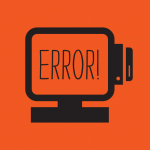An outdated point-of-sale (POS) system may not only be holding your business back, but endangering your customers as well. Many retailers, however, are reluctant to upgrade their payment processing systems and terminals because of the resources (i.e. money, time) required to do so.
“Every two to three years a big change emerges in retailing. Every four years in-store processes change. But retailers only change their POS every seven to 10 years. POS has become a big problem retailers need to solve,” said Leo Suarez of Toshiba Global Commerce.
While it’s easy to simply stick with the familiar, failing to switch to new POS technology can have serious consequences such as slower transactions, lack of usability and lost profits. In addition, if your POS system is behind the times, it’s very likely that you are putting your customer’s data at risk.
No business owner wants to spend unnecessary time or money, so how do you know when you really need to upgrade your business’s POS system? Here are the top five signs that indicate it’s time for an update:
1. It’s Not EMV-Compliant
By now you’ve probably heard about the rapidly approaching EMV liability shift. If your business isn’t equipped EMV-compliant POS systems by October 1, you will be liable for out-of-pocket coverage of losses due to fraudulent transactions. It’s critical for your business to update its POS system before the liability shift to ensure that you’re safe from these new costly consequences.
 2. It’s Not Customer-Friendly
2. It’s Not Customer-Friendly
Today’s shoppers are very tech-savvy and many don’t need any guidance on how to use POS systems. But, when your terminals aren’t functioning properly or aren’t integrated with a user-friendly software program, your customers will get easily frustrated–and unhappy customers are bad for business.
3. It’s a Standalone System
If your business has a standalone POS system, it’s probably perpetually outdated. Since this type of POS requires time-consuming manual software and hardware upgrades, it is extremely easy for business owners to let the technology slide. And once the technology gets so far behind, the cost to upgrade increases exponentially. An integrated solution, on the other hand, allows for software updates to be pushed through automatically, without requiring new hardware or much effort on the business’s end.
 4. Its Quirks are Just Getting Out of Hand
4. Its Quirks are Just Getting Out of Hand
Sick and tired of that coupon button not working? Fed up with your POS system’s tendency to shut of in the middle of a transaction? Save yourself the headache of dealing with these little “quirks” and invest in a new system–you’ll be amazed by how less stressed you feel, and how much time you’ll save!
5. It Doesn’t Align with Your Needs
Businesses are continually evolving, so your POS system should be flexible in order to meet your changing needs. Since your business will likely need to update your POS system due to the EMV liability shift, take this opportunity to pick out a system that will accommodate your needs several years down the road.
If your business is experiencing any of the above signs, it’s time for you to upgrade your POS system. Embrace the change! If you aren’t sure where to start, give us a call–we’re more than happy to help walk you through your POS system options and help you understand the updating process.
Stay updated on payment processing trends by following Abtek on Twitter and Facebook. Sign up to receive our newsletter, too.

